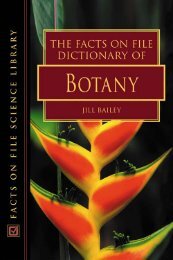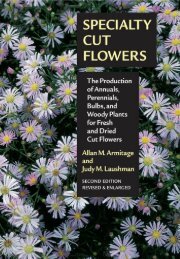You also want an ePaper? Increase the reach of your titles
YUMPU automatically turns print PDFs into web optimized ePapers that Google loves.
and the abaxial side forms the lower surface.<br />
A simple leaf may be dissected or lobed, and a<br />
compound leaf shows several leaflets (1.19); these,<br />
however, do not subtend axillary buds. In the<br />
lamina (leaf blade) a network of veins is present<br />
(1.20) which links to the vascular system of the<br />
stem. The axillary (Iatetal) buds may remain<br />
dormant but normally develop into side shoots, or<br />
form flowers. At the base of the main stem the<br />
cotyledons (first leaves formed in the embryo)<br />
demarcate it from the hypocotyl; the latter represents<br />
a transition zone between stem and root.<br />
In the angiosperms two groups have evolved<br />
which show distinct morphological, anatomical<br />
and floral characteristics (1.21). Thc dicotyledons<br />
(crucifers, begonias, willows, oaks) constitute<br />
about two-thirds of flowering plant species and<br />
the great majority show some degree of secondary<br />
(woody) thickening (1.2 to 1.4). Monocotyledons<br />
(grasses, bananas, lilies, 1.1) do not undergo<br />
secondary thickening in the same way as<br />
dicotyledons, bur in some genera large trees may<br />
develop (1.22).<br />
Dicotyledonous leaves are commonly petiolate<br />
(1.17) and normally show a narrow attachment to<br />
the stem. In monocotyledons the leaf is frequently<br />
sessile (without a petiole) and the leaf base often<br />
encloses a large sector of the stem (1.23). Leaves<br />
of dicotyledons are varied in shape and arrangement<br />
of their major veins but normally show a<br />
reticulatc pattern of the small interconnecting<br />
veins (1.20). In monocotyledons the leaf is<br />
typically elongate (1.22), with the main veins<br />
paralleling its length. Their relatively rare lateral<br />
connections 3re normally unbranched (1.24).<br />
In dicotyledons, the radicle (seedling root) is<br />
normally persistent and the older region often<br />
increases in diameter by secondary thickening<br />
(1.25). By contrast, in monocotyledons the radicle<br />
is usually not persistent and an adventitious root<br />
system develops from the base of the enlarging<br />
shoot. In a number of larger monocotyledons their<br />
heavy upright shoots are stabilised by adventitious<br />
proproots (1.26).<br />
Vascular anatomy of angiosperms<br />
The primary vascular systems of mono- and dicotyledons<br />
generally differ considerably (1.21). In<br />
a transverse section of the monocotyledonous<br />
stem (1.27) there arc many scattered vascular<br />
bundles, while in dicotyledons a smaller number<br />
of bundles is usually arranged in a cylinder outside<br />
10<br />
a wide pith (1.28). The roots of monocotyledons<br />
frequemly show a central pith with a large number<br />
of strands of alternating xylem and phloem on<br />
its periphery (1.29). But in the dicotyledons a starshaped<br />
core of x}'lem commonl}' occurs with strands<br />
of phloem lying between its several anns (1.14).<br />
In the majority of dicotyledons a fascicular<br />
cambium separates the primary xylem and phloem<br />
of both the stem and root (1.25, 1.28, 1.30). If<br />
secondary thickening occurs the normally discrete<br />
strands of cambium become linked, and the<br />
continuous ring of vascular cambium produces<br />
secondary xylem internally and secondary phloem<br />
externally (1.4, 1.30). Thc vast majorit}, of<br />
monocotyledons arc herbaceous; however, a<br />
number of palms grow into tall trees as a resulr of<br />
diffuse secondary growth. Others (Dracaena,<br />
Cordylilze) produce new {secondary) vascular<br />
bundles from a secondary thickening meristem<br />
and may form large trees (1.22).<br />
Floral and reproductive features<br />
of angiosperms<br />
In monocotyledons the floral parts (sepals, petals,<br />
stamens and carpels) commonly develop in threes<br />
(1.1, 1.21), whereas in dicotyledons these frequently<br />
occur in fives or fours (1.21). However, a<br />
large and indefinite number of floral parts occur<br />
in many other dicotyledons (1.31). The mature<br />
carpel (female pan of the flower, 1.31, 1.32)<br />
consists of several pans: the terminal stigma<br />
which receives the pollen (].l, J.31), an intermediate<br />
style (1.1) and the basal ovary (1.32). In<br />
most taxa the carpels are fused (syncarpy, 1.6)<br />
rather than free from each orher (apocarpy, 1.31).<br />
Within the ovary, one to numerous ovules are<br />
present and each contains an egg cell at the micropylar<br />
end of the ovule (1.32). The pollen grain<br />
germinates on the stigma and the pollen tube<br />
grows down the style to enter rhe ovule (1.32)<br />
where it liberates two haploid sperm nuclei.<br />
One of these fertilises the egg which forms the<br />
diploid zygote, while rhe other nucleus fuses with<br />
the twO centrally located polar nuclei (1.32) to<br />
give rise to the nutritive endosperm for the<br />
embryo. As the embryo develops from the zygote<br />
it enlarges and the surrounding tissues of the ovule<br />
expand to form the mature seed. The ovary<br />
concomitantly increases in size to form the mature<br />
fruit (1.6). In dicotyledons tWO cotyledons are<br />
present on the embryo (l.21, 1.33), bur in monocotyledons<br />
only a single one occurs (1.21).





